Yotam Ottolenghi baking recipes: Banana cake with tahini cream cheese icing, tahini and oat cookies
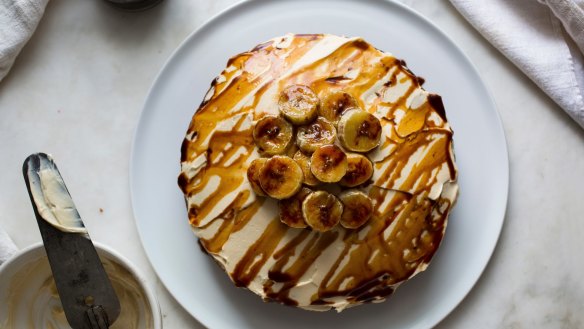
There are 10 or so things in my kitchen that I can't do without. Olive oil and lemons. Red wine vinegar and tomatoes, when they are in season. Coffee to start the day. Wine, bread, cheese and chocolate to end it. Tahini is there, too, ready to be drizzled on toast or whisked into a sauce or dressing.
If I were to lay these things out on my table, tahini might be, to many, the odd one out. For all of the other ingredients, there's a real range in quality that is widely accepted and understood. It's the difference between pre-sliced industrial white bread and handmade sourdough; between instant coffee and freshly ground beans; between run-of-the-mill vinegar and one that perfectly balances fruit and acidity. Or think of Sicilian unwaxed lemons, single-origin chocolate and artisanal cheese. We can draw a line between these more rarefied items and their mass-market counterparts.
But tahini? That jar sitting at the back of the cupboard, its contents split in two, with a layer of oil sitting on top of packed sesame paste? That jar you reach for to make hummus or baba ghanoush, its packaging timeless, rooted in the health food shop circa 1970?
For me, however, and everyone else who grew up in the Middle East, tahini is as loved and revered a staple as olive oil or wine. And, as with oil and wine, the variables for making exceptional tahini are wide and many.
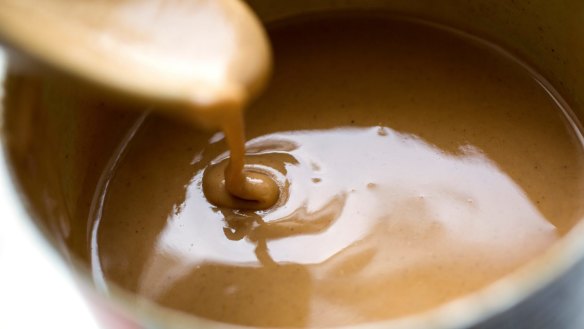
Unlike Greek or Cypriot tahini, which I find to be claggy and bitter, tahini from the Middle East is creamy enough to pour over porridge, nutty enough to spread on toast, and smooth enough to eat by the spoonful. Its colour can range from a light beige to a very deep red, depending on how long the seeds are roasted. It will still separate when it's left to sit, yes, with the oil rising to the top, but it comes together very smoothly when stirred.
Rare is the dish not improved with a drizzle of tahini sauce, made from simply mixing raw tahini with some lemon juice, water, garlic and salt. Grilled meats and fish, roasted root vegetables, a chopped fresh tomato and cucumber salad: All are enriched by it. A Palestinian main course like lamb siniyah makes a star of tahini, which is poured over cooked lamb and baked in the oven to form a thick and rich crust – an alternative to the mashed potatoes on top of a shepherd's pie, if you like.
Sweet things also welcome the creamy nuttiness of tahini. As well as baking tahini cookies and cakes, I like to make halva-studded brownies with tahini swirled through the batter before it goes in the oven. Good tahini is also delicious as is, drizzled over ice-cream.
A few years ago, I visited the Jebrini company, a small mill in East Jerusalem where tahini has been made for 130 years, to see how it is done. The Jebrini family has been there for decades, and the mill is now run by two brothers, making raw tahini just as their father and grandfather did before them. The pride taken in their product, the care with which it is made, the reverence for the source, process and method: it's not just hipster baristas with their pourover brewing methods who take their art seriously.
It starts with the sourcing of the sesame seed, the best of which is the coveted humera variety from Ethiopia, which has a real richness that other seeds from Mexico and India can lack. From there, it's all about the way the seeds are hulled and roasted, and then, crucially, the old millstones used to grind them. The basalt millstones at the Jebrini mill, for example, date back 200 years. When tahini is mass-produced, the seeds are not always perfectly peeled (leading to a tahini that is not perfectly smooth), and can be over-roasted (which leads to a bitter-tasting tahini) or not roasted at all. If just a few kilograms of tahini are being made each day, however, as at Jebrini, more control can be taken to produce the smoothest, creamiest and least bitter tahini.
Getting hold of what I call "proper" tahini – maybe it needs to be called "artisanal" to gain the kudos it deserves – outside the Middle East is not as easy as getting hold of either the 1970s style or the Greek or Cypriot varieties, but it is absolutely there to find, for those who want it, in Middle Eastern shops or online. The scale of production at a mill like Jebrini is more for the local market, but look for Al Arz from Israel (which I tend to use), Al Taj from Lebanon or the famous "camel tahini", Al-Jamal, from Palestine, with a camel on the label.
If what you think of as tahini is not creamy and delicious and nutty enough to eat directly from the jar, then you're missing a trick. Go seek it out.
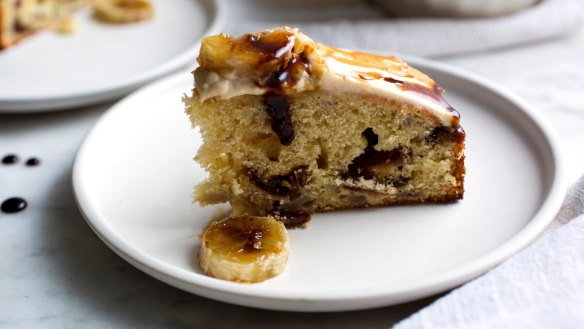
Sesame, date and banana cake
Ingredients
For the cake
50g tahini
75ml orange juice (from 1 large orange)
140g medjool dates, pitted and quartered (about 8 dates)
2 to 3 very ripe peeled bananas (240g), thinly sliced
1½ tbsp toasted sesame seeds
125g unsalted butter, at room temperature and cut into 2-centimetre pieces, plus extra butter for the tin
150g castor sugar
2 large eggs, beaten
200g plain flour, sifted
2½ tsp baking powder
⅛ tsp salt
For the tahini cream cheese icing
130g cream cheese, preferably at room temperature
130g mascarpone cheese, preferably at room temperature
35g lightly packed light brown sugar (soft sugar)
55g tahini
For the caramelised bananas
1 ripe peeled banana, cut into 1-centimetre slices
3 tsp demerara sugar
1½ tsp date syrup, for drizzling
Method
1. Heat oven to 190C. Grease a 20-centimetre springform cake tin with butter, and line the base and sides with baking paper.
2. Make the cake: In a medium bowl, whisk together tahini and orange juice, and then stir in dates, bananas and sesame seeds, separating the date and banana pieces as you add them to the bowl so they don't clump together. Set aside.
3. Put butter and sugar in the bowl of a stand mixer fitted with the paddle attachment and mix on medium-high speed for two to three minutes, until light and fluffy. Add the eggs, in two additions, until combined, scraping the bowl down as needed.
4. In a small bowl, whisk together flour, baking powder and salt, then add to the stand mixer bowl and mix on low speed for about 30 seconds, just to combine. Add tahini-date mixture with the speed still on low and mix until blended, then spoon the batter into the cake tin and smooth the top.
5. Transfer cake to oven and bake for 30 minutes, until golden brown. Without removing it from the oven, carefully cover the cake loosely with aluminum foil. Continue to bake for an additional 25 to 30 minutes, or until cake is cooked through and a skewer inserted in the middle comes out clean. Remove from oven and set aside to cool in the tin on a wire rack.
6. While the cake is baking, make the icing: Place all the ingredients in the bowl of a stand mixer fitted with the whisk attachment. Whisk for one to two minutes, on medium speed, until combined and airy, scraping down the sides of the bowl as needed to mix thoroughly. Set aside until cake has cooled.
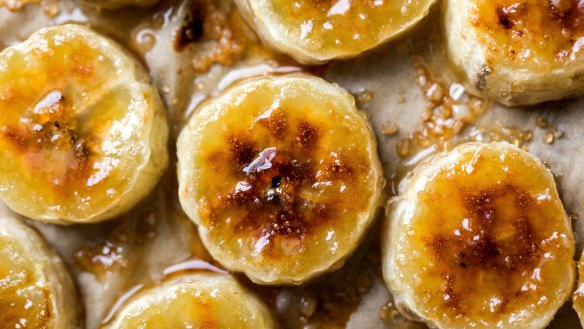
7. Make the caramelised bananas: Heat grill on its highest setting, with a rack placed about 10 centimetres beneath the heat source. Arrange banana slices closely together on a small baking tray and sprinkle generously with sugar. Grill bananas for two to three minutes, until sugar has melted and caramelised. Remove from oven and set aside to cool.
8. To assemble, remove the cake from the tin and transfer to a plate. Spread icing generously over the top of the cake. Arrange the caramelised bananas on top, then drizzle with date syrup.
Serves 8 to 10
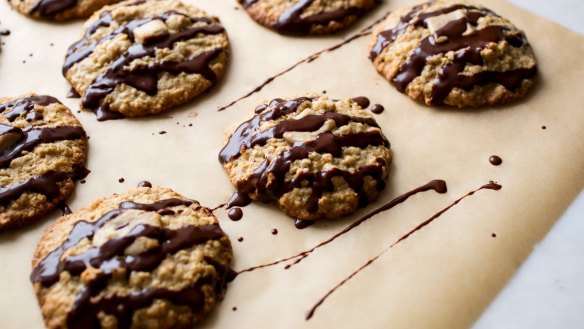
Oat and tahini cookies
80g softened unsalted butter, cut into 2-centimetre cubes
50g packed dark-brown sugar
110g castor sugar
1 large egg
½ tsp vanilla extract
60g tahini
50g plain flour
½ tsp baking powder
¼ tsp salt
140g old-fashioned rolled oats, pulsed a few times in a food processor to roughly chop
1 tsp finely grated orange zest (from half a small orange)
100g raw hazelnuts, toasted, peeled and chopped into ½-centimetre pieces (see note; or use blanched and peeled nuts, if available, and toast them for flavour before chopping)
1 tbsp toasted white sesame seeds
100g plain halva, broken into about 20 pieces roughly two centimetres wide
60g dark chocolate, roughly chopped
Method
1. Heat oven to 200C.
2. Place butter and both sugars in the bowl of a stand mixer fitted with a paddle attachment (or use a hand-held electric mixer). Mix on medium speed for two to three minutes, or until light and fluffy. Add egg, vanilla and one tablespoon plus ½ teaspoon water and continue mixing until combined, then blend in the tahini. (You may need to stop the machine and scrape down the sides of the bowl with a spatula a few times to help it combine.)
3. In a medium bowl, whisk together flour, baking powder, salt, oats, orange zest, hazelnuts and sesame seeds. Add the dry ingredients to the stand mixer bowl and mix on low speed until well blended.
4. Line two baking sheets with baking paper. Form 20 rough balls of dough (they should be about four to five centimetres wide) and arrange on the pans, spaced about four centimetres apart.
5. Bake for eight minutes, rotating the pans halfway through, then remove from the oven while the cookies are not quite cooked. Place a piece of halva in the middle of each cookie and return to the oven for another five minutes, or until cookies are golden-brown around the edges and the halva has started to melt. Remove from oven and set aside to cool for five minutes, then transfer to a wire rack to cool completely.
6. Place chocolate in a medium heatproof bowl and place over a pot of simmering water, taking care that the base of the bowl is not touching the water. Cook the chocolate, stirring occasionally, until melted. Remove from the heat and set aside.
7. Transfer the cookies back to one of the baking sheets so they fit snugly together. Using a teaspoon, drizzle the melted chocolate over the cookies to create thin stripes (or zigzags) all in the same direction. Don't worry about being exact with this as the cookies should look rustic. Set aside for the chocolate to harden, then serve.
Makes 20 cookies
©The New York Times
Appears in these collections
The best recipes from Australia's leading chefs straight to your inbox.
Sign up